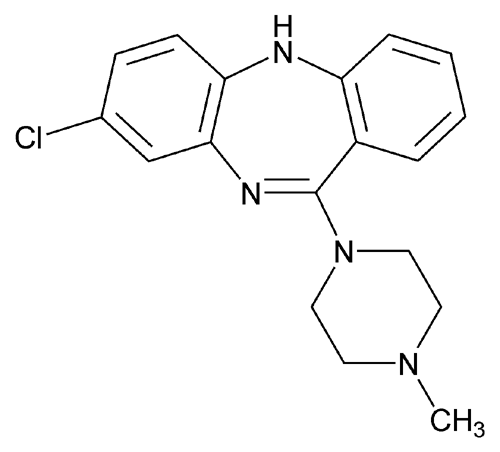Clozapine
» Clozapine contains not less than 98.0 percent and not more than 102.0 percent of C18H19ClN4, calculated on the dried basis.
Packaging and storage—
Preserve in well-closed containers.
Identification—
B:
The retention time of the major peak in the chromatogram of the Test solution corresponds to the major peak in the chromatogram of the Resolution solution, as obtained in the test for Related compounds.
Loss on drying  731
731 —
Dry it at 105
—
Dry it at 105 for 4 hours: it loses not more than 0.5% of its weight.
for 4 hours: it loses not more than 0.5% of its weight.
Residue on ignition  281
281 :
not more than 0.1%.
:
not more than 0.1%.
Heavy metals, Method II  231
231 :
0.002%.
:
0.002%.
Related compounds—
Diluent—
Prepare a mixture of methanol and water (80:20).
Buffer—
Dissolve about 2.0 g of monobasic potassium phosphate in 1000 mL of water, and adjust to a pH of 2.4 with phosphoric acid (85%). [note—The pH of this solution must not be below 2.4.]
Solution A—
Prepare a filtered and degassed mixture of Buffer, acetonitrile, and methanol (8:1:1).
Solution B—
Prepare a filtered and degassed mixture of acetonitrile, methanol, and Buffer (2:2:1).
Mobile phase—
Use variable mixtures of Solution A and Solution B as directed for Chromatographic system.
Resolution solution—
Dissolve 4 mg of USP Clozapine Resolution Mixture RS in 4 mL of methanol, add 1 mL of water, and dilute with Diluent to 10 mL.
Standard stock solution—
Dissolve an accurately weighed amount of USP Clozapine RS in Diluent to obtain a final solution having a known concentration of about 0.75 mg per mL of clozapine.
Standard solution—
Dilute quantitatively a known volume of the Standard stock solution with Diluent to obtain a solution having a known concentration of about 0.75 µg per mL of clozapine.
Test solution—
Dissolve 75.0 mg of the substance to be examined in 80 mL of methanol, and dilute with water to 100.0 mL.
Chromatographic system (see Chromatography  621
621 )—
The liquid chromatograph is equipped with a 257-nm detector and a 4.6-mm × 15-cm column that contains 5-µm L1 packing. The flow rate is about 1.2 mL per minute. The chromatograph is programmed as follows.
)—
The liquid chromatograph is equipped with a 257-nm detector and a 4.6-mm × 15-cm column that contains 5-µm L1 packing. The flow rate is about 1.2 mL per minute. The chromatograph is programmed as follows.
Chromatograph the Resolution solution, and record the peak responses as directed for Procedure. Locate the clozapine peak and the peaks due to the specified impurities using the relative retention times provided in Table 1; the resolution, R, between impurity C and clozapine, is not less than 2.5. Chromatograph the Standard solution, and record the peak response as directed for Procedure: the relative standard deviation for replicate injections for clozapine is not more than 5.0%.
| Time (min.) |
Solution A (%) | Solution B (%) | |
| 0–4 | 100 | 0 | isocratic |
| 4–24 | 100®0 | 0®100 | linear gradient |
| 24–29 | 0 | 100 | isocratic |
| 29–40 | 0®100 | 100®0 | linear gradient |
Procedure—
Separately inject equal volumes (about 20 µL) of the Standard solution and the Test solution into the chromatograph, record the chromatograms, and measure the peak response for clozapine obtained from the Standard solution and the responses for all other peaks, except the clozapine peak, obtained from the Test solution. [note—Disregard any peak with an area less than 0.5 times the area of the clozapine peak in the chromatogram obtained from the Standard solution.] Calculate the percentage of each related compound and any unknown impurity in the portion of Clozapine taken by the formula:
100(CS / CT)(1/F)(ri / rS)
in which CS and CT are the concentrations of clozapine, in mg per mL, in the Standard solution and the Test solution, respectively; F is the relative response factor for each impurity (given in Table 1); ri is the peak response for each individual peak obtained from the Test solution; and rS is the clozapine peak obtained from the Standard solution. The limits for the specified and unspecified impurities are given in Table 1.
Table 1
| Peak | Approximate Relative Retention Time |
Relative Response Factor |
Limit (w/w %) |
| Impurity C1 | 0.9 | 1.0 | NMT 0.3 |
| Clozapine | 1.0 | — | — |
| Impurity D2 | 1.1 | 0.35 | NMT 0.2 |
| Impurity A3 | 1.6 | 1.2 | NMT 0.1 |
| Impurity B4 | 1.7 | 1.0 | NMT 0.2 |
| Individual unspecified impurity | — | 1.0 | NMT 0.10 |
| Total impurities | — | — | NMT 0.6 |
|
1
8-Chloro-11-(piperazin-1-yl)-5H-dibenzo[b,e][1,4]diazepine.
|
|||
|
2
4-Chloro-N1-(2-((4-methylpiperazin-1-yl)carbonyl)phenyl)benzene-1,2-diamine.
|
|||
|
3
8-Chloro-5,10-dihydro-11H-dibenzo[b,e][1,4]diazepin-11-one.
|
|||
|
4
11,11¢-(Piperazine-1,4-diyl)bis(8-chloro-5H-dibenzo[b,e][1,4]diazepine).
|
|||
Assay—
Transfer about 115 mg of Clozapine, accurately weighed, to a suitable container, dissolve in 70 mL of glacial acetic acid, and titrate with 0.1 N perchloric acid VS, determining the endpoint potentiometrically. Perform a blank determination, and make any necessary correction. Each mL of 0.1 N perchloric acid is equivalent to 16.34 mg of C18H19ClN4.
Auxiliary Information—
Please check for your question in the FAQs before contacting USP.
Chromatographic Column—
| Topic/Question | Contact | Expert Committee |
| Monograph | Ravi Ravichandran, Ph.D.
Senior Scientist 1-301-816-8330 |
(MDPP05) Monograph Development-Psychiatrics and Psychoactives |
| Reference Standards | Lili Wang, Technical Services Scientist 1-301-816-8129 RSTech@usp.org |
USP32–NF27 Page 2005
Pharmacopeial Forum: Volume No. 33(5) Page 893
Chromatographic columns text is not derived from, and not part of, USP 32 or NF 27.

